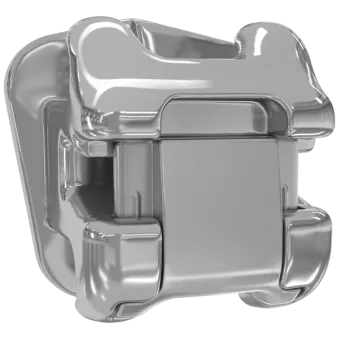
The Difference Between Clear and Traditional Metal Braces
We all remember seeing metal braces prevalent around us while growing up. Our peers changing the colored rubber ties to celebrate a holiday, favorite sports team, or to match an outfit – the only way to help make metal braces look somewhat appealing. An aesthetically pleasing alternative was virtually non-existent, and braces that caused less pain were unheard of and simply a fantasy. Rather, getting braces as a child was more a rite of passage that typically lasted no less than 24 months.
In today’s “selfie” driven society, with social media playing a significant driving factor in appearances around the clock, not just while away from home, the desire and need for an aesthetically pleasing option for orthodontic treatment has become much more sought after among adolescents and adults alike. Given society’s focus on constant interaction via video chat or other means, a visually appealing alternative to braces is a driving factor in a patient’s decision to seek orthodontic treatment. To that end, patients expect results that are fast, pain-free, and do not significantly impact their daily activities.
The orthodontic industry understands these concerns and with the use of technological advancements, a progressive, forward-thinking system like the Damon System, has been able to address these concerns, designed for aesthetics, comfort, and overall treatment time. Not to be confused with clear aligners, clear or ceramic braces were developed as an aesthetically pleasing alternative option to what people know to be metal braces. The Damon Brand has both a metal and clear option, called Damon Clear. Furthermore, additional technology has been incorporated into the Damon self-ligating brace, which can allow for more comfort during treatment and overall reduced treatment time.1 Compared to traditional braces, Damon self-ligating braces helps reduce patient pain and can significantly lower treatment times in most cases.2
How do braces work?
Braces are used to treat a variety of problems associated with the misalignment of teeth and bite discrepancies. The way orthodontists treat these problems is with the use of constant low-pressure forces on teeth to promote orthodontic tooth movement. These low forces allow for the regeneration of bone surrounding teeth, ultimately leading to corrective measures to realign teeth and address bite discrepancies. Traditional braces typically have three components which make up the entire system: (i) the bracket, (ii) the wire, and (iii) a ligature tie. While the brackets are physically adhered to each individual tooth, it is the wire placed in the bracket slot that applies the constant low-pressure forces, which ultimately leads to the desired tooth movement. With traditional braces, ligature ties (i.e., the colored rubber ties that we were all so used to changing) are used to keep the wire engaged to the bracket. However, advances in technology in newer systems of braces such as Damon braces, have created an alternative solution to hold the wire in place. These are referred to as self-ligating braces and can be made using clear materials as well. These, in part, are how the Damon System was able to increase comfort, reduce treatment time, all while achieving a more visually appealing alternative to traditional metal braces.3
Do Braces hurt? How long will I have to wear braces?
Two of the most commonly asked questions from patients is “will my braces hurt?” and “how long will I need to wear them for?” Many patients find that Damon self-ligating braces are more comfortable than traditional braces. The reason for this is due to the fact that the forces placed on the teeth are more gradual, with consistent pressure, allowing for more comfort during treatment.4 This approach is different than using traditional braces, which use ligature ties not allowing for the same gradual, consistent movements – and in turn comfort. Rather, in traditional braces, the wires are “tightened” at each visit causing the potential for more pain as the wires are constantly reactivated. On the other hand, the Damon System does not require these “tightening” visits, since the wires are always active, allowing the light forces to act over a period of time. Since these light forces promote gradual tooth movement, it results in: (i) less patient visits because the wires do not require regular tightening, (ii) less treatment discomfort, and (iii) shorter treatment times because the wires are consistently active.5
Why choose clear braces?
The aesthetic appeal of clear braces makes it a popular choice for treating orthodontic cases. Clear braces are made from a ceramic or tooth-colored material, thereby allowing them to blend in with the color of the teeth, and in turn, making them less visible. Furthermore, aesthetic wires (i.e. clear/white wires) can be used to further mask the appearance of having braces.
It is important to keep in mind that although clear braces have many advantages for those looking for an alternative option, they may be prone to discoloration. However, clear braces combined with improved patient comfort and shorter treatment times, makes Damon Clear braces an attractive option.6
Final Thoughts
The significant advancements in technology making their way into the orthodontic industry, coupled with innovative, patient focused orthodontists, have led to the development of alternative treatment options that reduce treatment time and patient discomfort – in addition to being a more visually pleasing option.7 Clear braces do all those things. The Damon System, in particular, provides an alternative to traditional braces and achieves optimal results, all while making the process efficient and comfortable. Through its forward-thinking braces, an alternative to traditional techniques, The Damon System’s moves the industry forward and addresses some of the most common questions that come with orthodontic treatment.
About the Author:
Dr. Manika Agarwal is a board-certified orthodontist who earned her certificate in orthodontics from the University of Illinois at Chicago along with her MS in oral biology. Prior to residency, she obtained her dental degree with honors from the University of Pennsylvania and her Bachelor of Science in Neuroscience from the University of Michigan. She maintains active memberships in the American Association of Orthodontists and other organizations in order to stay up to date with the latest innovations in the field.


